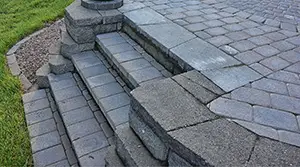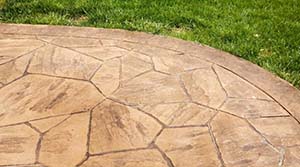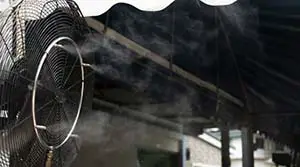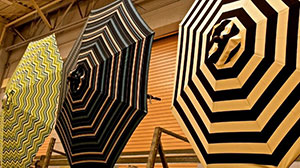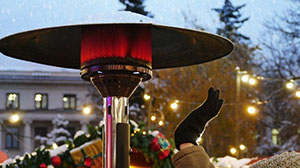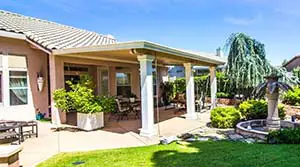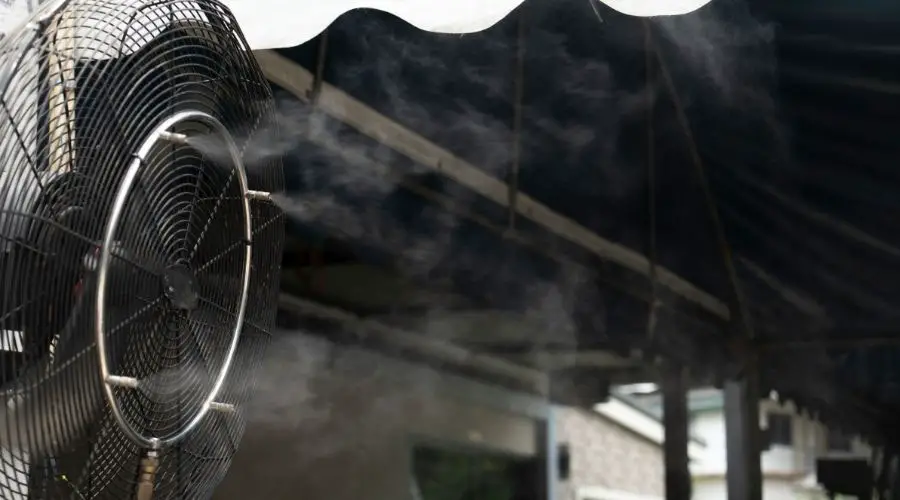
Misting fans create and distribute tiny water molecules in the air, evaporating and cooling the surrounding area. So, you can use them on your deck or patio on hot summer days to get some relief from the heat.
Here are seven tips you need to know when using them on the deck or patio:
- Factor in the size of your outdoor space
- Consider the cooling requirements within the space
- Think about your misting fans portability
- Consider the water type & availability
- Check out the additional misting fan features
- Safeguard your hearing
- Observe safety protocols
With that being said, you’ll need to understand how it works, its limitations, and how to use it to your advantage. So, it would be best to understand which type of fan to use on your deck or patio, water availability, where to place it, and how it operates.
The wrong choice of a misting fan or your inability to use it correctly will leave you all sweaty and irritated during hot summers when you need it most.
This article provides the information you need to understand how misting fans work, how to select the right type and the correct way to use it to keep you cool in the outdoors.
It will also teach you the advantages and disadvantages of misting fans, so you can determine if they are suitable for you.
Do Misting Fans Increase Humidity?
A misting fan is an evaporative cooling device that consists of two primary components: a misting system and a fan. The dampness helps increase humidity in the room; however, you will only need a sufficient amount of water for it.
Generally, the fan mist ring will release tiny water droplets from an attached water source into the fan vents. Then, your fan will blow the mist into the surrounding areas to keep it cool. If a misting fan works as intended, you will experience cool air but not feel wet.
It is worth noting that the water droplets must come from somewhere. Some misting fans can connect to a garden hose, while others have an inbuilt water reservoir that you need to fill before using. The latter option is much easier to use indoors because there is minimal risk of leakages.
How Do You Use a Misting Fan?
For a standard misting fan to work effectively, a pump must push water at a decent pressure averaging 1000 pounds per square inch (PSI).
At that point, the nozzle openings on the fan mist ring will restrict the amount of water coming out. As a result, it will form a mist.
Misting fans utilize the principle of evaporation to keep the air cool. So, the fan spreads the water droplets, mix with warm air, and result in an energy exchange as they evaporate.
When that happens, they leave the surrounding air cooler, thus enabling you to enjoy your deck or patio even during the hottest times of the year.
Tips for Using Misting Fans on a Deck or Patio
How well you understand misting fans will determine their effectiveness in cooling your deck or patio. Below are some tips you can implement when selecting and using equipment of that nature.
1. Factor in the Size of Your Outdoor Space
The size of the outdoor space you want to keep cool will partly determine the misting fan you select. If you have ample outdoor space, you need a misting fan that generates enough water droplets to cool the entire area without making you wet.
So, think about the square foot coverage. For example, if a misting fan has a 600 SF designation, it implies it can cool up to 600 square feet of space.
Another is the size of the fan also matters since it affects the range of distribution. More giant fans can create more cool air within a specified area than smaller versions.
In addition, the presence or absence of a water reservoir is worth considering too. For outdoor spaces, a connection to a water hose would provide water for misting purposes for as long as you need it without the need to refill anything.
However, if you have a misting fan with a water tank, you must fill it. So, the larger the tank, the fewer times you will refill it, even if the fan cools a more extensive outdoor space.
2. Consider the Cooling Requirements within Your Space
Your misting fan’s airflow speed, pressure, discharge temperature delta, and cubic feet per minute (CFM) airflow will partly determine its ability to cool your space significantly so you can feel the temperature difference. The latter is a measure of how much air your misting fan can move per minute when at its highest speed.
To determine the ideal CFM airflow, you need to estimate the volume of the space you need to cool by multiplying its length by width and height. Then you can multiply that volume by the air changes per hour recommended for your area.
After that, divide the result by 60 to determine the ideal CFM airflow your misting fan should offer. Most misting fans have CFM numbers ranging from 200 CFM to 5000 CFM.
The larger the space to be cooled and the more people it will hold, the higher the CFM values the misting fan should serve that space adequately.
The misting fan’s airflow speed, measured in revolutions per minute (RPM), partly determines the rate at which water droplets will distribute to the environment.
Pressure is also a crucial factor to consider for any space that needs cooling. The larger or hotter the area that needs cooling, or the more people it has, the more likely you will require a high-pressure misting fan.
High-pressure misting fans (800 to 4000 PSI) usually consist of high-pressure pumps that create very tiny water droplets that result in flash evaporation, which cool the air faster.
For low-pressure misting fans (20 to 100 PSI), pumps are not always necessary, and the water hose will do as a source of the mist whose droplets are not as tiny.
Mid-range pressure misting fans (100 to 250 PSI) will do the required job in standard residential properties.
3. Think About Your Misting Fans Portability
Usually, the most significant indicator of a misting fan’s portability is its “empty weight.” Lighter fans are easier to carry or move around than heavier ones, thus making them more convenient for outdoor use.
The second issue that determines a misting fan’s portability is the presence of a rechargeable battery, how long it can operate, and how much charge it holds.
That power feature will ensure your fan runs for a while on your deck or patio, even if there is no electrical socket to plug it in.
The length of the charging cable also affects a misting fan’s portability. If it is long, even if it doesn’t have a rechargeable battery, you can plug it into an electrical outlet indoors and move it outdoors, so it cools your patio or deck.
Also, if your misting fan is tankless, it may not be as portable as you like because that will limit its functionality to areas where you can connect a hose.
If the tap is much farther away from the patio or deck than the length of your existing hose, you cannot use that fan no matter how easy it is to carry or move around your yard.
4. Consider the Water Type & Availability
Misting fans cannot work without correct water flow since they are evaporative cooling systems. For that reason, you should consider the availability and type of water for the fan.
For tankless misting fans, you have no choice but to connect them with a water hose to a tap somewhere. So, you should ensure you have an outdoor water source or one close to your deck or patio before buying and using a misting fan of that nature.
On the other hand, if you have a misting fan with a water tank, you can use it outdoors without needing an outdoor tap.
Most of these tanks tend to average one to five gallons. The latter size of the water tank may last up to eight hours before needing a refill.
Remember, tanks are bulky. So, misting fans with water reservoirs will likely be heavier and require more effort to maneuver, thus affecting their portability. For that reason, some manufacturers have designed these fans to have wheels and handles.
In addition, you should factor in your water’s pressure and the fan’s nozzle to determine the available water for your misting system.
Also, remember that your misting fan will not produce enough mist for cooling your outdoor space if your water pressure is too low. The same thing will happen if your water pressure is low or average, but the fan has nigger nozzle openings.
Another issue is how clean your water is. If your water contains debris, your misting system openings will clog up and reduce the rate at which water converts into a mist. So, you won’t feel as cold as you would like, even when the fan is operating at full speed.
The water pump also affects water availability. If you want to supply more than one misting fan, you have no choice but to get a pump.
Those devices that produce higher pressure will increase the amount of mist that comes through the fan’s misting ring, while those with lower pressure will create less fog.
Some of the pressure tends to get lost due to the length the water has to travel. So that’s something to think about too.
5. Check Out the Additional Misting Fan Features
There is more to misting fans than their basic functionality. So, it pays to consider the additional features too.
For starters, think about a fan’s ability to tilt and to what extent it does so. That’s because it can partly determine the direction of cooling air, thus affecting how convenient it is to use.
You can also factor in a fan’s oscillating capabilities. Some misting fans can oscillate in a 360° direction. Remember, the greater the fan’s oscillating ability, the larger the area it can cool on your deck or patio.
However, some misting fans tend to move up and down instead of side to side. However, if such devices have a shorter height, their up-and-down movement is unlikely to be effective.
The body of your misting fan and the material it consists of is worth thinking about too. If the fan works predominantly outdoors, it should probably consist mainly of heavy-gauge metal that is rust-proof, water-proof, and durable. That way, it can withstand the elements better.
However, metal fans are usually much heavier than plastic ones. But the latter may not be as tough and durable as their metallic counterparts.
Additionally, think about your misting fan’s aesthetic appeal, especially if you intend to install it in a visible part of your patio or deck. If what you choose is unattractive, consider using an oscillating fan that you can mount on a hidden wall or behind plants.
Furthermore, some misting fans offer an insect repellant feature. So, you can stay cool while keeping annoying insects like mosquitos away from you.
6. Safeguard Your Hearing
Your ability to hear well into your old age partly depends on the noises you expose yourself to. And prolonged noise exposure can cause hearing loss in the long term.
When you expose yourself for a long time to devices louder than 85 A-weighted decibels (dBA), you may end up with a hearing loss. However, anything below 70 dBA is usually safe.
For these reasons, you need to use a misting fan that safeguards your hearing by producing low noise. And if you have no choice but to get a louder fan, install it farther away from your patio or deck to try and reduce its negative impact on your ears.
Generally, giant misting fans cooling more extensive areas or those operating at much higher speeds tend to be louder. In addition, misting fans that work with high-pressure pumps will produce more noises due to the pumping action.
7. Observe Safety Protocols
It is best to engage common sense when dealing with a misting fan so that you can operate it safely and use it for a long time.
For example, consider the electric demands of the misting fan and its pump. They should be compatible with your power supply and not overpower your electrical systems.
Also, they should come with features such as low voltage controls and thermal relief valves to safeguard them from electricity fluctuations and overheating.
It would also be wise for you to research online to determine if any brand on your short list has been recalled for safety issues such as electric shock. In that case, you cannot afford to use it on your deck or patio and hope for good results.
Third, you need to use filters to prevent clogging where hard water or debris is concerned. And if your misting system nozzles are already clogged, you can use the appropriate cleaning fluid or a pin to remove the rubbish.
Furthermore, you could install the misting fan to face the source of the breeze so it can spread the mist farther. However, remember that a strong wind will overpower the fan and interfere with its ability to cool your outdoor space.
The placement of a misting fan also matters. You must provide an outlet for air to escape to prevent humidity from building up and stop the device from functioning. So, you may want to open your patio doors to aid in the cooling process.
Disadvantages of a Misting Fan
Like any other product, a misting fan has its fair share of limitations. Below are some of them.
- Misting fans may fail to work well if you use hard water or a source that produces debris. You will need to clean them every two years or so to keep them working in peak condition.
- Misting does not cool the air as fast as an air conditioner does. In addition, you cannot use the misting fan during cold seasons since it cannot heat the air.
- If your fan is not working correctly, your misting system will be ineffective.
- If you live in an area with water issues, a misting fan on your deck or patio may consume more water than you intend to use, especially on scorching summer days and nights.
- Misting fans are not as effective in humid areas. That’s because humidity limits the evaporation rate, thus reducing the device’s ability to cool your outdoor space.
Advantages of a Misting Fan
While misting fans have limitations, they offer several benefits to make up for them. Here are some of these benefits.
- Misting fans are evaporative cooling devices that help combat heat stress by reducing temperatures within a space. As a result, they can keep people safe from issues like heat strokes during hot summer months.
- Misting fans cool the environment and help improve productivity, especially in hot commercial spaces with plenty of heat.
- If you use a misting fan, you will use less energy than an air conditioning system, resulting in lower energy bills.
- Unlike air conditioning systems, misting fans do not require an enclosed space to be effective. So, you can use them for cooling both your indoor and outdoor spaces.
- Many brands offer portable misting fans that you can carry around to stay cool even with no electrical outlet nearby. That makes the fan a very convenient cooling device.
- If you opt for a misting fan with an insect repellant feature, you can stay cool outdoors without worrying about attacks from insects like mosquitoes.
- Misting fans are more affordable than their air conditioning unit counterparts. Typically, you will pay an average of $2,715 for an outdoor misting unit.
On the other hand, a central air conditioning unit will cost you an average of $5,661, and yet it is unlikely to work effectively in the outdoors.
Final Thoughts
While misting fans have several limitations, they offer many benefits. They can keep you cool and safe from overheating no matter which area of your yard you are in. In addition, they are affordable to buy and install and consume less power.
So long as you select the correct fan and have a steady water source, you can enjoy its effects for a long time to come. For these reasons, you should consider them as a way of cooling your outdoor space during hot and dry summer months. They are well worth the money you will pay.
Sources

